13. Linking growth mode to lengths of single-walled carbon nanotubes.
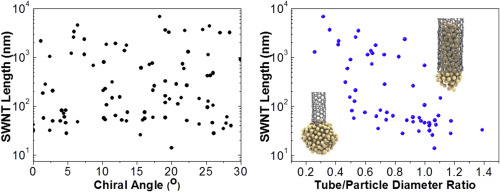 Abstract : Elucidating the key factors that determine the lengths of single-walled carbon nanotubes (SWCNTs) is of great importance for understanding the origin of chiral selectivity. We use transmission electron microscopy to thoroughly investigate as-grown SWCNTs...
Abstract : Elucidating the key factors that determine the lengths of single-walled carbon nanotubes (SWCNTs) is of great importance for understanding the origin of chiral selectivity. We use transmission electron microscopy to thoroughly investigate as-grown SWCNTs...
Download article in pdf
URL of the article
12. Nuclear quantum effects on the thermal expansion coefficient of hexagonal boron nitride monolayer.
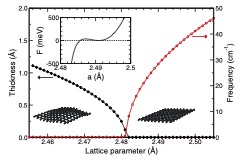 Abstract : This work examines the importance of vibrational delocalization on a basic thermomechanical property of a hexagonal boron nitride monolayer, namely its thermal expansion coefficient (TEC). Using a recently parametrized bond-order potential of the Tersoff type...
Abstract : This work examines the importance of vibrational delocalization on a basic thermomechanical property of a hexagonal boron nitride monolayer, namely its thermal expansion coefficient (TEC). Using a recently parametrized bond-order potential of the Tersoff type...
Download article in pdf
URL of the article
11. Size dependent phase diagrams of Nickel-Carbon nanoparticles.
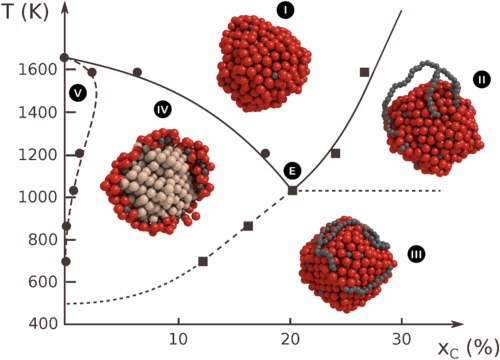 Abstract : The carbon rich phase diagrams of nickel-carbon nanoparticles, relevant to catalysis and catalytic chemical vapor deposition synthesis of carbon nanotubes, are calculated for system sizes up to about 3 nm (807 Ni atoms)...
Abstract : The carbon rich phase diagrams of nickel-carbon nanoparticles, relevant to catalysis and catalytic chemical vapor deposition synthesis of carbon nanotubes, are calculated for system sizes up to about 3 nm (807 Ni atoms)...
Download article in pdf
Download SI in pdf
URL of the article
10. Interplay between Raman shift and thermal expansion in graphene: Temperature-dependent measurements and analysis of substrate corrections.
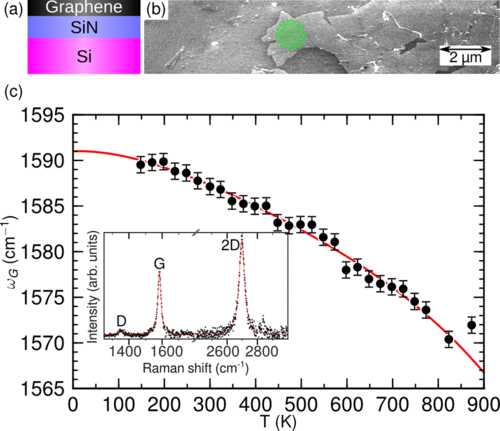 Abstract : Measurements and calculations have shown significant disagreement regarding the sign and temperature variations of the thermal expansion coefficient (TEC) of graphene α(T)...
Abstract : Measurements and calculations have shown significant disagreement regarding the sign and temperature variations of the thermal expansion coefficient (TEC) of graphene α(T)...
Download article in pdf
Download SI in pdf
URL of the article
9. Thermal expansion of freestanding graphene: benchmarking semiempirical potentials.
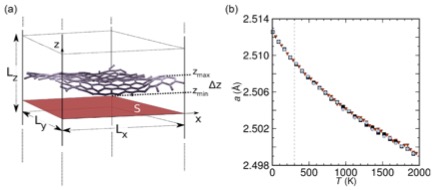 Abstract : The thermodynamical properties of free-standing graphene have been investigated under constant zero pressure as a function of temperature using Monte Carlo simulations. A variety of atomistic models have been used, including the simple three-body Stillinger potential...
Abstract : The thermodynamical properties of free-standing graphene have been investigated under constant zero pressure as a function of temperature using Monte Carlo simulations. A variety of atomistic models have been used, including the simple three-body Stillinger potential...
Download article in pdf
URL of the article
8. Effective embedded-atom potential for metallic adsorbates on crystalline surfaces.
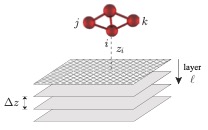 Abstract : Based on the embedded-atom method (EAM), an analytical effective potential is developed to model the interaction of a metallic adsorbate on a perfect crystalline substrate, which is also metallic...
Abstract : Based on the embedded-atom method (EAM), an analytical effective potential is developed to model the interaction of a metallic adsorbate on a perfect crystalline substrate, which is also metallic...
Download article in pdf
URL of the article
7. Monte Carlo Study of Magnetic Resistivity in Semiconducting MnTe.
![]() Abstract : We investigate in this paper properties of the spin resistivity in magnetic semiconducting MnTe of the NiAs structure. MnTe is a crossroad semiconductor with a large band gap. It is an antiferromagnet with a Néel temperature around 310 K. Due to this high Néel temperature, there are many applications using its magnetic properties...
Abstract : We investigate in this paper properties of the spin resistivity in magnetic semiconducting MnTe of the NiAs structure. MnTe is a crossroad semiconductor with a large band gap. It is an antiferromagnet with a Néel temperature around 310 K. Due to this high Néel temperature, there are many applications using its magnetic properties...
Download article in pdf
URL of the article
6. Spin transport in magnetically ordered systems : effect of the lattice relaxation time
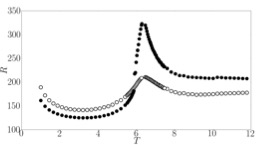 Abstract : Spin resistivity R has been shown to result mainly from the scattering of itinerant spins with magnetic impurities and lattice spins. R is proportional to the spin–spin correlation so that its behavior is very complicated near and at the magnetic phase transition of the lattice spins...
Abstract : Spin resistivity R has been shown to result mainly from the scattering of itinerant spins with magnetic impurities and lattice spins. R is proportional to the spin–spin correlation so that its behavior is very complicated near and at the magnetic phase transition of the lattice spins...
Download article in pdf
URL of the article
5. Spin resistivity in the Frustrated J1-J2 Model.
Abstract : We study in this paper the resistivity encountered by Ising itinerant spins traveling in the so-called J1 - J2 frustrated simple cubic Ising lattice. For the lattice, we take into account the interactions between nearest-neighbors and next-nearest-neighbors, J1 and J2 respectively. Itinerant spins interact with lattice spins via a distance-dependent interaction. We also take into account an interaction between itinerant spins. The lattice is frustrated in a range of J2 in which we show that it undergoes a very strong first-order transition. Using Monte Carlo simulation, we calculate the resistivity ρ of the itinerant spins and show that the first-order transition of the lattice causes a discontinuity of ρ...
Download article in pdf
URL of the article
4. Monte Carlo Spin Transport in Antiferromagnetic Films: Application to MnTe.
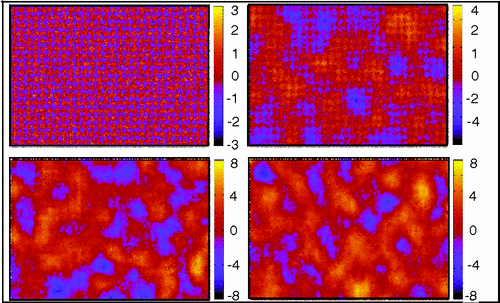 Abstract : In this paper we study the parallel spin current in an antiferromagnetic semiconductor thin film where we take into account the interaction between itinerant spins and lattice spins. The spin model is an anisotropic Heisenberg model. Here we use the Boltzmann equation with numerical data on cluster distribution obtained by Monte Carlo simulations and cluster-construction algorithms...
Abstract : In this paper we study the parallel spin current in an antiferromagnetic semiconductor thin film where we take into account the interaction between itinerant spins and lattice spins. The spin model is an anisotropic Heisenberg model. Here we use the Boltzmann equation with numerical data on cluster distribution obtained by Monte Carlo simulations and cluster-construction algorithms...
Download article in pdf
URL of the article








